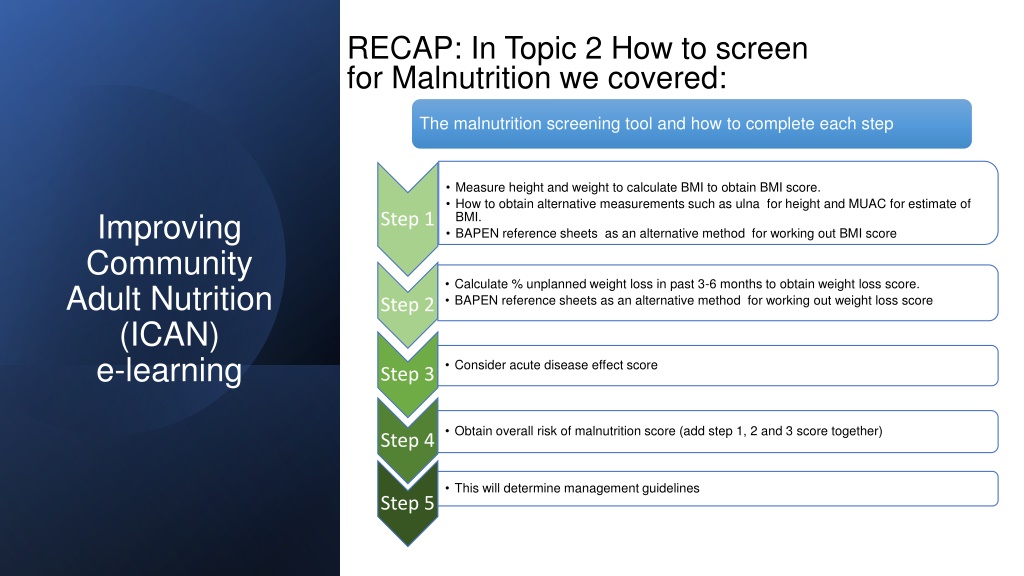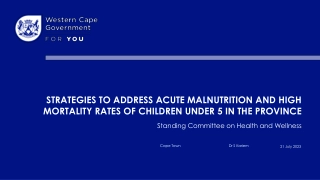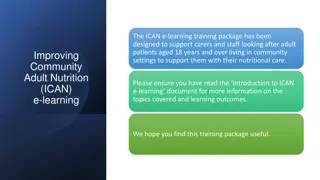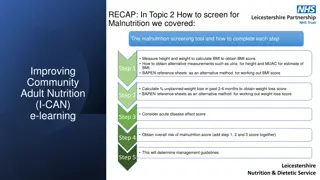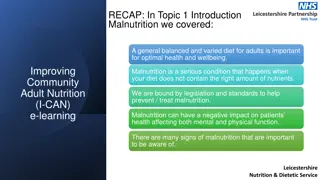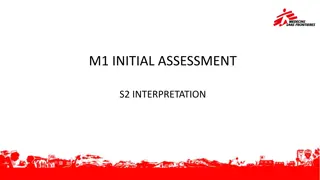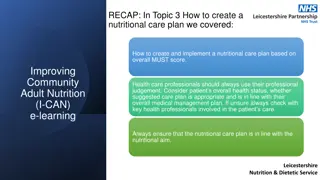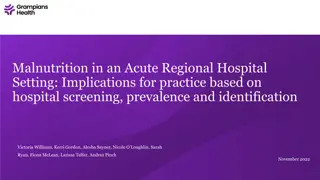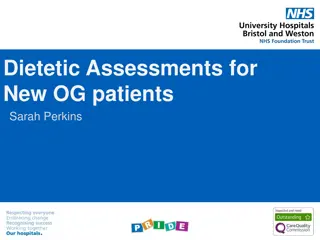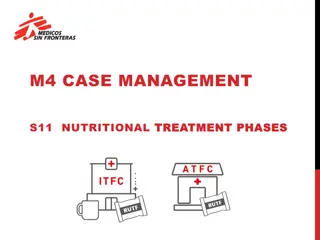Nutritional Care Planning for Malnutrition Screening
Learn how to screen for malnutrition using tools like BMI calculation and weight loss assessment. Understand the steps to create a nutritional care plan based on MUST scores, including setting aims, implementing agreed plans, and monitoring progress. Gain insights into managing malnutrition risks and promoting overall health and wellbeing through appropriate actions.
Download Presentation

Please find below an Image/Link to download the presentation.
The content on the website is provided AS IS for your information and personal use only. It may not be sold, licensed, or shared on other websites without obtaining consent from the author.If you encounter any issues during the download, it is possible that the publisher has removed the file from their server.
You are allowed to download the files provided on this website for personal or commercial use, subject to the condition that they are used lawfully. All files are the property of their respective owners.
The content on the website is provided AS IS for your information and personal use only. It may not be sold, licensed, or shared on other websites without obtaining consent from the author.
E N D
Presentation Transcript
RECAP: In Topic 2 How to screen for Malnutrition we covered: The malnutrition screening tool and how to complete each step Measure height and weight to calculate BMI to obtain BMI score. How to obtain alternative measurements such as ulna for height and MUAC for estimate of BMI. BAPEN reference sheets as an alternative method for working out BMI score Improving Community Adult Nutrition (ICAN) e-learning Step 1 Calculate % unplanned weight loss in past 3-6 months to obtain weight loss score. BAPEN reference sheets as an alternative method for working out weight loss score Step 2 Consider acute disease effect score Step 3 Obtain overall risk of malnutrition score (add step 1, 2 and 3 score together) Step 4 This will determine management guidelines Step 5
Leicestershire Nutrition & Dietetic Service ICAN - How to create a Nutritional Care Plan Please DO NOT save or share this PowerPoint to avoid circulation of out of date information
Aims: Learning how to create an appropriate nutritional care plan based on MUST score Examples of patient centred nutritional aims that could be used Appropriate actions to take in line with MUST score
Step 5: Management plan In the previous PowerPoint you have learnt how to screen for malnutrition and obtain an overall MUST score. It is important the MUST score is acted upon and a nutritional care plan based on this score is in place to manage the risk of malnutrition.
How to create a nutritional care plan This should be based on the MUST score Set nutritional aims (there should be a clear outcome or end-point for the action) State agreed plan to be implemented State monitoring to be carried out Aims should be reviewed at the agreed timescales and action taken depending on whether they are being achieved or not Management plans included in this guidance are based on our local guidelines: LLR APC Managing Malnutrition in Adults in Primary Care Guidelines
Aims may include: Gain a set amount of weight Maintain weight Improve nutritional intake to support: - Skin health - Post surgery/infection - Maintain general health and wellbeing Minimise further weight loss Achieve adequate fluid intake To achieve the aim we have to create a nutritional care plan. This will be different depending on the MUST score.
Management plan: Low Risk If nutrition score is low risk : Ethel s MUST score is 0, therefore low risk management plan should be put in place MUST score 0 Encourage a well balanced diet Check weight monthly Repeat MUST screening tool monthly or sooner if any concerns
Management plan: Medium Risk If nutrition score is Medium risk : Document dietary intake for 3 days If eating portion of all meals and puddings, repeat screening at least monthly MUST score 1 If eating less than portion of all meals and puddings, there may be clinical concern therefore: Set nutritional aim Implement food first and fortification advice (covered in next presentation) to improve and increase overall nutritional intake Offer home-made or over the counter milkshakes/nourishing drinks Monitor and review care plan regularly (covered in next presentation) Repeat MUST screening tool in 4 weeks or earlier if appropriate
Management Plan: High Risk If nutrition score is High risk : Set nutritional aim MUST SCORE 2+ Implement food first and fortification advice as for medium risk Offer home-made or over the counter milkshakes/nourishing drinks If no weight gain and/or MUST score increased after 4 weeks, ask GP to refer to LLR APC Managing Malnutrition in Adults in Primary Care Guidelines Repeat MUST screening at least monthly
Managing Malnutrition Flowchart Please see useful flowchart for a summary of the MUST Score Management plans based on local guidance. This is page 18-APPENDIX 1 from LLR APC Managing Malnutrition in Adults in Primary Care Guidelines. Please click on the above link to take you to the flowchart
Summary You should now be familiar with how to create and implement a nutritional care plan based on overall MUST score. It is worth noting that in addition to the MUST score, health care professionals should always use their professional judgement. Consider patient s overall health status and whether suggested care plan is appropriate and in line with their overall medical management plan. If unsure always check with key health professionals involved in the patient s care. Always ensure that the nutritional care plan is in line with the nutritional aim.
Knowledge Check: Ethel is 79 years old. She is currently staying in a residential care home and has recently had a chest infection. She is eating less than half portions of her usual meals and puddings. She has lost further weight and now has a MUST score of 2. 1. An appropriate aim may include: - To minimise further weight loss - OR to improve oral intake post infection 1. What is your nutritional aim? 2. Which management plan would you implement? 2. The correct management plan would be for High Risk as her overall MUST score is 2 3. If Ethel hasn t gained any weight after 4 weeks or her MUST score has increased, who should you refer the patient to? 3. Ask GP to refer to LLR APC Managing Malnutrition in Adults in Primary Care Guidelines and continue to repeat MUST screening at least monthly
